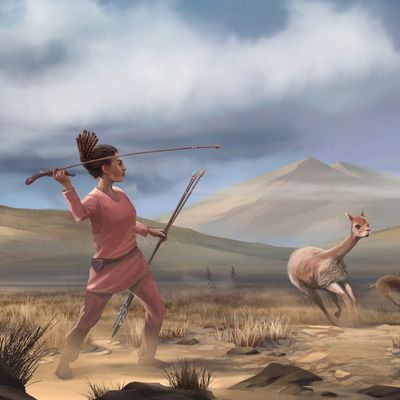
For long, we’ve been led to believe that within prehistoric hunter-gatherer societies, there was a stark, unambiguous sexual division of labor: While the burly men ventured off to kill big animals for food, the women stayed behind with the children, busying themselves foraging for leaves and berries and whatnot. Perhaps you’ve even been convinced that this is just logical. Well, as an enlightening new study suggests — joining a growing body of research — we’ve been misled.
In 2018, a group of archaeologists were excavating at a site called Wilamaya Patjxa, in modern-day Peru, when they uncovered the bones of a 9,000-year-old human, buried alongside an impressive tool kit of stone projectile points and blades. “Everybody was talking about how this was a great chief, a big man,” the lead study author, archaeologist Randy Haas of the University of California, told Science magazine. But Jim Watson of the University of Arizona, who noticed that the bones were smaller, was preoccupied by a different thought: “I think your hunter might be female,” he told Haas.
Lo and behold, after studying the skeleton’s teeth and bones, the researchers confirmed Watson’s suspicion: The remains belonged to a female who died between the ages of 17 and 19, and she hunted big game like vicuña and deer. This then led Haas and his team to reexamine other ancient burials in the Americas, and they found at least ten additional reports of women who were buried with projectile points, suggesting that they, too, were big-game hunters. While the researchers were apprehensive to make any sweeping conclusions in their findings, which were published in the journal Science Advances, they suspect that “early big-game hunting was likely gender neutral.” (At least in the Late Pleistocene and Early Holestene.)
As one might expect, some archaeologists are resistant to accept the notion that prehistoric women may have been big-game hunters, as it directly challenges a prevailing theory about hunter-gatherer societies. But this hypothesis, which dates back to the mid-1960s, when a cabal of leading male anthropologists descended on Chicago to discuss the notion at the “Man the Hunter” conference, has been increasingly discredited. In 2017, for example, scientists confirmed that remains interred in a prominent Viking warrior grave did not belong to a man, as long assumed, but instead to a woman.
“Our findings have made me rethink the most basic organizational structure of ancient hunter-gatherer groups, and human groups more generally,” Haas said in a statement. “[L]ikely because of [historic] sexist assumptions about division of labor in Western society — archaeological findings of females with hunting tools just didn’t fit prevailing worldviews. It took a strong case to help us recognize that the archaeological pattern indicated actual female hunting behavior.”
At long last, our prehistoric huntresses are getting the fame and recognition they’ve been unduly denied.

